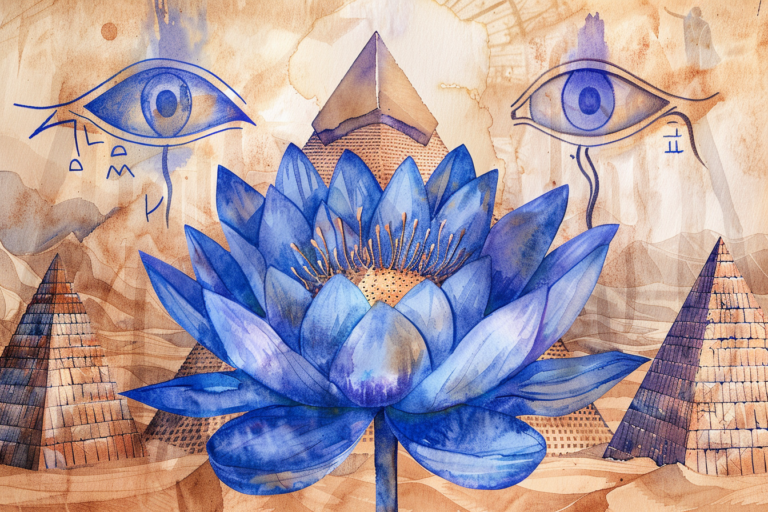
The Blue Lotus, also known as Nymphaea caerulea, is a water lily that has been used for its medicinal and psychoactive properties for thousands of years in various cultures around the world.
One of the most well-known properties of the Blue Lotus is its psychoactive effects. It has been used to induce a state of relaxation, euphoria, and transcendence in various cultures. It contains alkaloids, flavonoids, and other compounds that are believed to produce these effects.
In addition to its psychoactive properties, the Blue Lotus has also been used for medicinal purposes. It has been used to treat a variety of ailments, including anxiety, insomnia, and digestive issues. It contains compounds that have anti-inflammatory, antioxidant, and analgesic effects.
The Blue Lotus has also been used for its aromatic properties. It has a sweet, floral scent and has been used to make perfumes, oils, and other cosmetic products.
Overall, the Blue Lotus is a plant with a rich history and diverse properties that have been valued by various cultures for thousands of years.
The ancient Egyptians used Blue Lotus, also known as Nymphaea caerulea, for various purposes, including religious ceremonies, medicine, and recreation.
In religious ceremonies, the Blue Lotus was considered a sacred plant and was believed to have the power to bring about spiritual enlightenment and induce a state of transcendence. The Egyptians would often depict the Blue Lotus in their artwork, and it was also used in temple rituals and offerings.
The Blue Lotus was also used for medicinal purposes. The Egyptians believed that it had the power to cure various ailments, including anxiety, insomnia, and digestive issues. They would use the flowers, leaves, and roots of the Blue Lotus to make teas, oils, and tinctures.
In addition to its spiritual and medicinal uses, the Blue Lotus was also used for recreation. The Egyptians would soak the flowers in wine and drink the mixture, which would produce a relaxing and euphoric effect. This practice was common among the elite, who would often hold banquets where Blue Lotus wine was served.
Overall, the Blue Lotus played an important role in ancient Egyptian culture and was highly regarded for its spiritual, medicinal, and recreational properties.
The Greek physician Dioscorides, who lived in the first century AD, wrote about the medicinal properties of the Blue Lotus in his famous book, “De Materia Medica.” He recommended it for a variety of ailments, including digestive issues, insomnia, and anxiety.
The Blue Lotus was also highly valued for its aromatic properties. The Greeks used the flower to make perfumes and oils, and it was considered a luxurious ingredient in many cosmetic products.
In addition to its medicinal and cosmetic uses, the Blue Lotus was also known for its psychoactive properties. The Greek philosopher and historian Plutarch wrote about its use as an intoxicant, describing how it was soaked in wine and then consumed to induce a state of euphoria.
The Blue Lotus was also mentioned in Greek mythology, where it was associated with the god Apollo and was said to have grown in the waters of the River Styx, which separated the world of the living from the world of the dead.
Overall, the Blue Lotus played an important role in Greek culture and was highly valued for its medicinal, aromatic, and psychoactive properties.
Like the Greeks, the Romans used the Blue Lotus for its aromatic properties. It was a popular ingredient in perfumes and was also used to scent bathwater and other cosmetic products.
The Blue Lotus was also used for its medicinal properties. The Roman naturalist and philosopher, Pliny the Elder, wrote about the flower’s therapeutic benefits in his book “Natural History.” He recommended it as a treatment for diarrhea and dysentery and claimed that it could also be used to relieve anxiety and promote restful sleep.
In addition to its medicinal and cosmetic uses, the Blue Lotus was also valued for its psychoactive properties. The Roman poet Ovid wrote about its use as an aphrodisiac, describing how it could stimulate desire and enhance sexual pleasure.
The Blue Lotus was also used in Roman banquets and parties, where it was often consumed in wine or other alcoholic beverages to produce a relaxing and euphoric effect.
Overall, the Blue Lotus was highly valued by the ancient Romans for its therapeutic, aromatic, and recreational properties, and it played an important role in their culture and society.
The Blue Lotus was associated with the Hindu god Vishnu and was considered a symbol of purity, enlightenment, and spiritual awakening. It was often depicted in Hindu art and mythology, and it was used in various religious rituals and ceremonies.
In Ayurvedic medicine, the traditional system of medicine in India, the Blue Lotus was used for its medicinal properties. It was believed to have a range of therapeutic benefits, including the ability to improve digestion, reduce inflammation, relieve pain, and promote relaxation and calmness.
The Blue Lotus was also used as a natural remedy for anxiety, stress, and insomnia. It was commonly consumed as a tea or mixed with other herbs to create a calming and relaxing blend.
In addition to its cultural and medicinal uses, the Blue Lotus was also used for its psychoactive properties. The ancient Indian text, the “Rigveda,” describes the Blue Lotus as a plant with the power to induce a state of euphoria and transcendence.
Overall, the Blue Lotus played an important role in ancient Indian culture and was highly regarded for its cultural, spiritual, and medicinal significance.